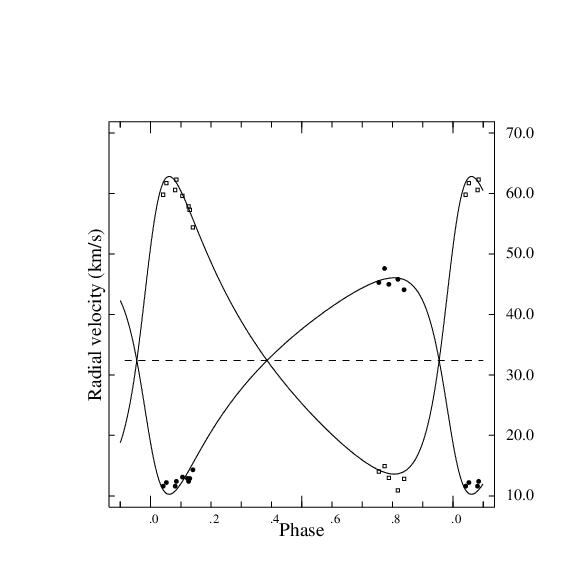Basic data (System:1058)
| C1900.0 | : | 18229+7241
|
|---|
| C2000.0 | : | 182103383+72435824
|
|---|
| Comp. | :
|
|---|
| Magn. | : | 3.57(V)
|
|---|
| Spect. | : | F7V
|
|---|
Identifiers:
| Bayer $\chi$ Dra | BD +72 839 | Flamsteed 44 Dra | GAIADR2 2266693630693473024
|
| GAIADR3 2266693630693473024 | GJ 713 | HD 170153 | HIP 89937
|
| HR 6927
|
Orbit
| Element | | Value | Std. dev.
|
|---|
| Period (d.) | : | 280.550 |
|
|---|
| Periastron time (xJD-2,400,000.0) | : | 46006.0 |
|
|---|
| Reference T0/epoch | : | JD
|
|---|
| Eccentricity | : | 0.45 |
|
|---|
| omega primary (deg.) | : | 121.7 |
|
|---|
| K1 (km/s) | : | 17.9 |
|
|---|
| K2 (km/s) | : | 24.6 |
|
|---|
| V0 (km/s) | : | +32.4 |
|
|---|
| sigma residuals primary | : |
|
|---|
| sigma residuals secondary | : |
|
|---|
| #RV primary | : | 14
|
|---|
| #RV secondary | : | 13
|
|---|
| Grade | : | 5.0
|
|---|
| Contributor | : | DAO
|
|---|
| Status | : | PUB
|
|---|
| Bibcode | : | 1987AJ.....93.1236T
|
|---|
|
|---|
|
|
|---|
| Derived quantities (on the fly, from the above quantities) |
|---|
|
|---|
|
|
|---|
| a1sini (km) | : | 6.16684e+07 | 0
|
|---|
| a2sini (km) | : | 8.4751e+07 | 0
|
|---|
| m1sin**3 i (sol.mass) | : | 0.923383 | 0
|
|---|
| m2sin**3 i (sol.mass) | : | 0.671892 | 0
|
|---|
Note
These observations and orbital elements supersede those determined by W.H.
Wright (Astrophys. J., 11, 131, 1900), by R.T. Crawford (Lick Obs. Bull., 13,
176, 1928), and even the excellent orbital elements derived by J.M.
Vinter-Hansen (Lick Obs. Bull., 19, 141, 1942). Other investigations that
confirmed Vinter-Hansen's were published by M. Spite (Ann. Astrophys., 30, 211,
1967) and H.A. Abt and S.G. Levy (Astrophys. J. Supp., 30, 276, 1973). The
principle improvements made by the new observations are a complete
determination of the secondary velocity-curve obtained by observing in the red
and near infrared, and the use of speckle-interferometric observations to give
a good determination of the astrometric orbit. Previously only Spite had
succeeded in observing the secondary spectrum -- and then only a few times.
Observations of the secondary have been used to determine only K2 and V0 (which
differs insignificantly from the value obtained from observations of the
primary). Similarly, the spectroscopic values of P, T and e were adopted in the
analysis of the astrometric orbit. This orbit, like its spectroscopic
counterpart, supersedes earlier work (H.L. Alden, Astron. J., 45, 113, 1936;
L.A. Breakiron and G. Gatewood, Publ. Astron. Soc. Pacific, 86, 448, 1974) and
confirms the conclusion by W.J. Luyten (Publ. Minnesota Obs., 2, 15, 1934) that
there is no third body in the system. The orbital inclination is 75 deg, the
major semi-axis is 0.122" and the parallax is 0.120". The stars have masses of
1.03 MSol and 0.75 MSol and their luminosities are consistent with their being
slightly metal-poor and 8E9 years old. Two faint companions are listed in
I.D.S. at about 150".
Radial velocities used in this orbit
| xJD | Rad.Vel. | O-C or error | Weight | Component | Offset | Comment
|
| -2,400,000.0 | (km/s) | (km/s) | | | (km/s) |
|
| 44356.992 | 12.9 | | 1.0 | a | |
|
| 44358.009 | 12.4 | | 1.0 | a | |
|
| 44358.009 | 57.9 | | 1.0 | b | |
|
| 44359.004 | 12.9 | | 1.0 | a | |
|
| 44359.004 | 57.3 | | 1.0 | b | |
|
| 44362.000 | 14.3 | | 1.0 | a | |
|
| 44362.000 | 54.4 | | 1.0 | b | |
|
| 44534.596 | 45.3 | | 1.0 | a | |
|
| 44534.596 | 14.0 | | 1.0 | b | |
|
| 44626.062 | 11.6 | | 1.0 | a | |
|
| 44626.062 | 60.6 | | 1.0 | b | |
|
| 44627.068 | 12.4 | | 1.0 | a | |
|
| 44627.068 | 62.3 | | 1.0 | b | |
|
| 44832.723 | 45.8 | | 1.0 | a | |
|
| 44832.723 | 10.9 | | 1.0 | b | |
|
| 44895.605 | 11.6 | | 1.0 | a | |
|
| 44895.605 | 59.8 | | 1.0 | b | |
|
| 44898.564 | 12.2 | | 1.0 | a | |
|
| 44898.564 | 61.7 | | 1.0 | b | |
|
| 45104.965 | 45.0 | | 1.0 | a | |
|
| 45104.965 | 13.0 | | 1.0 | b | |
|
| 45755.032 | 13.1 | | 1.0 | a | |
|
| 45755.032 | 59.6 | | 1.0 | b | |
|
| 45942.607 | 47.6 | | 1.0 | a | |
|
| 45942.607 | 14.9 | | 1.0 | b | |
|
| 45960.629 | 44.1 | | 1.0 | a | |
|
| 45960.629 | 12.8 | | 1.0 | b | |
|
Plot

Encapsulated PostScript file
T. Merle

